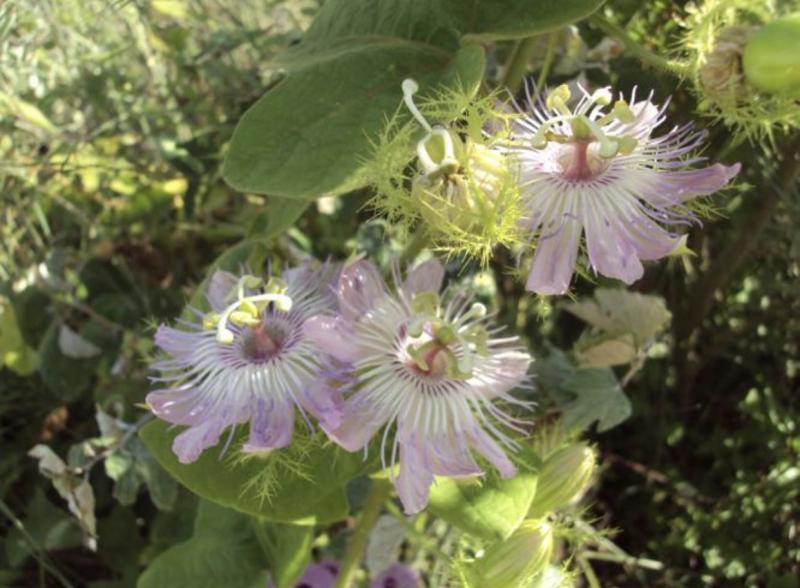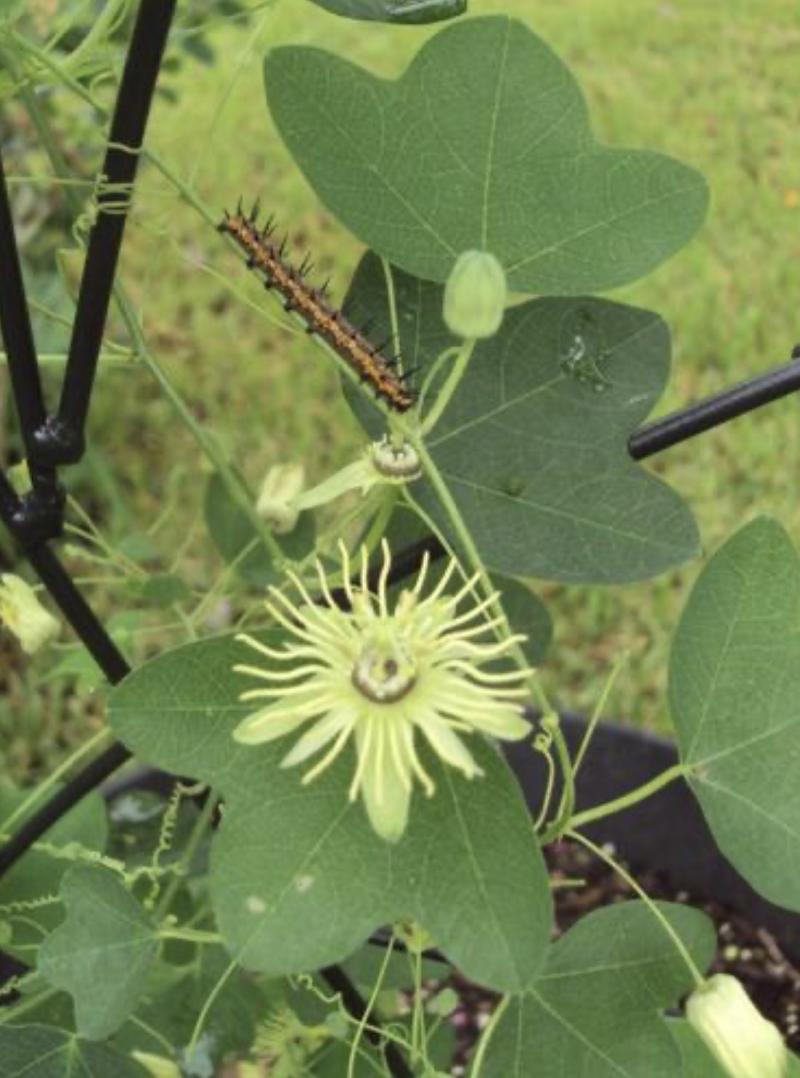 Victoria County Master Gardener Association
Victoria County Master Gardener Association
ph: 361-935-1556
nancyk
2022 Apr 15

PHOTO CONTRIBUTED BY VICTORIA COUNTY MASTER GARDENER JANET MCCREA
Gulf Fritillary Butterfly and bee gather on a passionflower blossom.
PASSIONFLOWER
Flower has religious significance
April 15, 2022
by Janet McCrea/Victoria County Master Gardener
Edited by Suzanne LaBrecque/Victoria County Master Gardener

PHOTO BY VICTORIA COUNTY MASTER GARDENER JANET MCCREA
Passiflora foetida - Passionflower

PHOTO CONTRIBUTED BY VICTORIA COUNTY MASTER GARDENER JANET MCCREA
Labeled drawing of Passionflower

PHOTO CONRIBUTED BY VICTORIA COUNTY MASTER GARDENER JANET MCCREA
Passiflora lutea with Gulf Fritillary butterfly caterpillar
NATIVE PASSIFLORA SPECIES
- Passiflora incarnata-Maypop
- Passiflora lutea-Yellow
- Passiflora foetida-Corona de Cristo
RESOURCES:
Lady Bird Johnson Wildflower Center Plant Database www.wildflower.org/plants/
Aggie Horticulture-Passion Flower
Texas Gardener-Planting Passion by Scott Perry
The Symbolism of the Passion Flower by Elaine Jordan
The Gardeners’ Dirt is written by members of the Victoria County Master Gardener Association, an educational outreach of Texas A&M AgriLife Extension – Victoria County. Mail your questions in care of the Advocate, P.O. Box 1518, Victoria, TX 77901; or vcmga@vicad.com, or comment on this column at VictoriaAdvocate.com.
Many years ago, a woman brought a passionflower to church that she had grown. I remember how exquisite the flower was, and how intrigued I was by her story of the flower’s symbolism. She claimed that parts of the flower represented the passion of Christ, a term that refers to the events that led up to the crucifixion of Jesus. Since I couldn’t remember many of the details of her story, I did a little research.
Legend has it that in the 1600s, a Spanish missionary found the passionflower vine and later had a dream in which each part of the blossom was related to Christ’s crucifixion. He thought this revelation was God’s gift to help the missionaries teach people in the New World about the events leading to Christ’s death.
First of all, many passionflowers are purple, the liturgical color of the season of Lent.
Passionflowers have five sepals and five petals, which are associated with the 10 faithful apostles present with Jesus at his crucifixion. Peter, the denier, and Judas Iscariot, the betrayer, are excluded.
The radial filaments in the center, called the corona, are symbolic of the crown of thorns put on Jesus’ head. There can be more than 100 of these filaments in a blossom.
The five anthers represent Christ’s wounds, one in each hand, one in each foot, and one in His side. Above the anthers are the three knob-like stigmas, which relate to the three nails that held Jesus to the cross.
One account related the passionflower vine’s leaves to the Roman spear, but another account related the three-lobed leaves to the Holy Trinity. Tendrils on the vine are representative of the Roman whips used in lashing Christ.
The fruit of the Passionflower is round, symbolizing the sinful world that Christ came to save by sacrificing His life.
In 1737, Linnaeus named the genus Passiflora, or Passionflower, ensuring its continued religious significance.
There are over 400 species of Passiflora. Most passionflowers are grown for their beautiful flowers, which come in purple, blue, pink, red, white, and yellow.
Passionflowers also attract butterflies. It is the larval host plant for the Gulf Fritillary, Zebra Longwing, and Julia butterflies. The caterpillars will defoliate the vine, but the reward will be a yard full of butterflies.
One species native to our area is Passiflora incarnata. It is sometimes known as Maypop because it produces a small, edible fruit that “pops” when stepped on. Fragrant purple/lavender flowers are 2 to 3 inches across, while the vigorous vine can grow 25 feet in length and will need a sturdy trellis or support.
This passionflower likes full sun, but tolerates afternoon shade. P. incarnata is heat and drought tolerant, but may need some supplemental water as fruits are maturing.
Fruits are ripe when they change in color from green to yellow-orange. Inside the fruit are numerous seeds coated in translucent goo, which can be sucked off. Inside the skin is a thick layer of white pulp that can be scraped off with a spoon and eaten.
If a passion vine freezes, trim off the dead parts, and it will regrow once weather warms. All Passiflora species spread by root suckers, and many will appear once the plant is established.
In fact, this is how I acquired my first passionflower. It traveled underground from my neighbor’s yard and came up in one of my flowerbeds. Native Passiflora species have three-lobed leaves while non-native species, like P. incense, have leaves with five lobes.
If you enjoy butterflies in your yard, planting a native species of Passiflora is a must.
ph: 361-935-1556
nancyk
